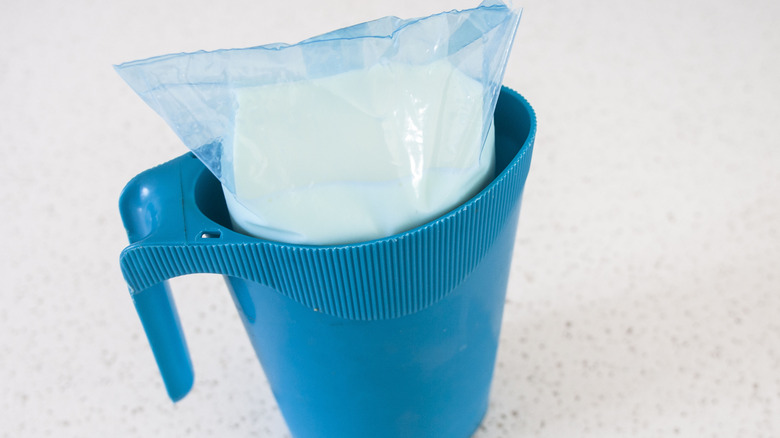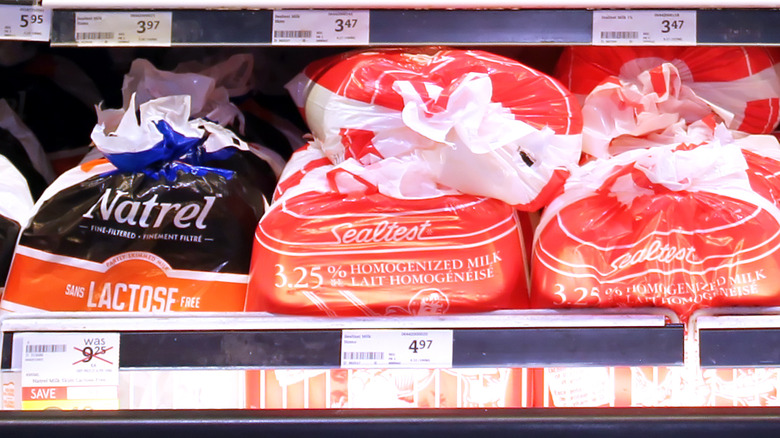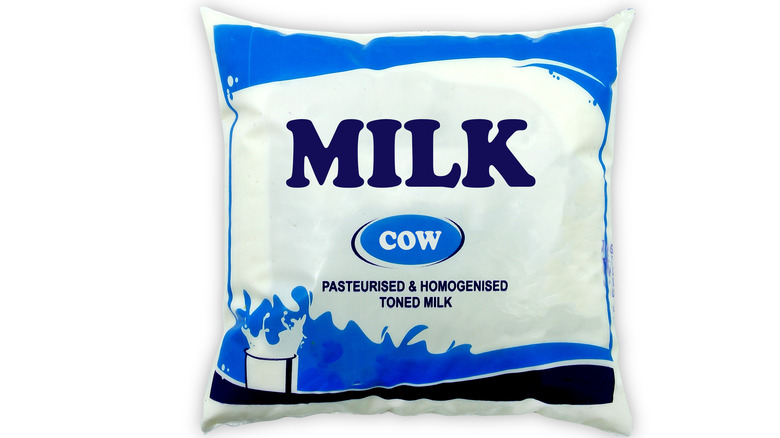Why Does Canada Sell Milk In Bags?
Correction 10/13/22: A previous version of this article stated that 1.3 liters equates to 1 liquid gallon. 1.3 liters is approximately 0.34 liquid gallons.
Regardless of the type of milk you drink, you probably know that it comes in more than one kind of packaging. In the United States, plastic jugs and paperboard aseptic containers (the kind used for almond milk) are among the most common. Glass bottles, which were much more widespread in the late 1800s and early 1900s (via Drink Milk in Glass Bottles), can also be found on grocery store shelves today.
In parts of Canada, though, plastic bags are the most popular packaging for milk. According to Food Network Canada, they're sold mainly along the eastern coast of Canada. Each plastic bag holds 1.3 liters of milk, which is the equivalent of about just over one-third (0.34) of a standard gallon. The bags are made with un-resealable plastic, so you have to snip the corner and place the bag into a pitcher for pouring.
It seems a little inconvenient, so why does Canada sell milk in bags? How long has bagged milk been available? And where else in the world can you find bagged milk?
Bagged milk in Canada dates back to the 1960s
The reason for the plastic milk packaging dates back to the 1960s, according to Food Network Canada. Before then, milk was still packaged in glass bottles in Canada, but replacing broken bottles was becoming too expensive. In an attempt to lower the cost, a Canadian food and packaging company called DuPont created plastic bags in 1967 that could store milk.
Another factor that led to the change from glass to plastic involves Canada's measurement system change. Before April 1, 1975, the country used the imperial system, as the United States currently uses, but the country changed to the metric system (per the Angus Reid Institute) coincidentally during the same time as the rising popularity of milk bags. Plastic bag manufacturers were able to easily resize the milk bags using the new metric system, unlike hard plastic manufacturers, as Food Network Canada explains.
But over time, plastic jugs became more popular in certain parts of Canada and eventually replaced milk bags (via CBC-Radio Canada). However, due to certain restrictions in Ontario, milk bags have remained popular in that part of the country.
What other countries sell bagged milk?
While milk bags may seem like a bizarre, inconvenient packaging method for some manufacturers, Canada is not the only country that embraced it. More than a dozen other countries sell bagged milk, including the United Kingdom, Iran, Israel, India, South Africa, Mexico, Argentina, Uruguay, Ecuador, and Russia, according to WorldAtlas.
Some parts of the United States also started selling bagged milk decades ago, including Wisconsin, Minnesota, and Iowa (via Tire Meets Road). In the 1990s, DuPont Liquid Packaging Systems started manufacturing the Mini-Sip, a small polyethylene pouch about the size of an apple (per Food Engineering), in the U.S. and other places. These pouches became popular in schools, including College Place Elementary and three other Washington schools, according to The Seattle Times. The schools chose to start using Mini-Sips as part of a pilot program aimed at reducing waste.
Like Canada, other countries started selling bagged milk because it was cheaper than replacing glass bottles. And while many parts of Canada and other countries discontinued this packaging method, you can still find bags of milk in Ontario, Québec, and the Maritimes.


